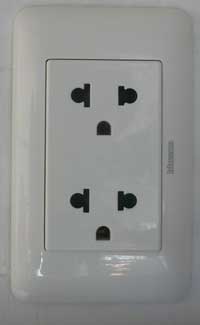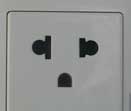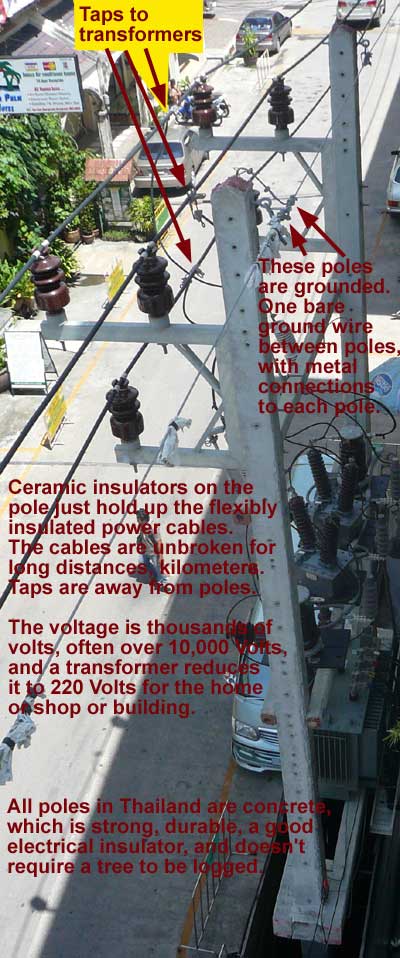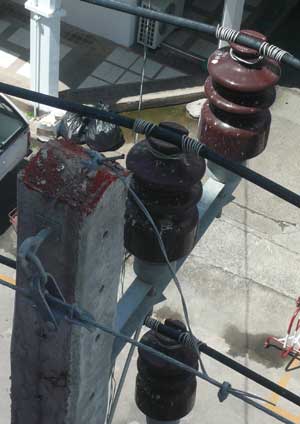
Electricity in Thailand
Socket and Plug Geometry
 The electricity in Thailand is 220 volts, 50 cycles/sec. (If you have 110 Volt appliances, see the bottom of this page.)
The electricity in Thailand is 220 volts, 50 cycles/sec. (If you have 110 Volt appliances, see the bottom of this page.)
The photo to the left shows the wall receptacle design usually found in Thailand. They accomodate both flat prongs (like in the U.S. and Japan) and round prongs (like much of Europe and Asia). Actually, most receptacles in Thailand are two prong, missing the third grounding/earthing prong at the bottom. However, the newest office and condominium dwellings usually offer the third prong due to increased awareness of the importance of grounding for both safety and equipment damage reasons.
Most devices run fine on 2 prongs, but some things should have a ground for reasons of both safety and equipment damage, as discussed later in this article.
Cost of electricity
The cost of electricity in Thailand is stated in terms of cost per "unit", in which 1 unit = 1 kilowatt-hour (kWh). In most parts of Thailand, the government rate has been held at around 4 baht per kilowatt hour. This applies to houses and condominiums. However, apartments usually have a higher rate, usually between 5 and 7 baht per unit. (The difference between an "apartment" and a "condominium" is that one owner owns an entire apartment building or block and rents them all out, whereas condominium units are owned by individual owners, i.e., a condominium building has condo units with different owners. Condominiums are like houses in this regard.)
In some parts of Thailand, the electricity is priced according to usage, in order to give a break to the poor and charge the wealthy a bit more, so that the first xxx units cost a lower rate, and the cost per unit goes up with higher monthly consumption, with some maximum rate such as 6 baht per unit.
Electrical Grounding / Earthing
It is strongly recommended that you read the rest of this article if you wish to maximize personal safety as regards getting electric shocks, and to minimize possible damage to your appliances. If you think it may be too difficult for you technically, then I suggest you print it and keep it handy for other people who may help you. I would suggest printing both this page and the one on grounding. (If your browser doesn't print it right, then try again on landscape mode.)
Just because there are three prongs, you cannot assume the receptacle is wired properly. Sometime in the mid 1990s, buildings under construction started offering receptacles with 3 prongs, due to increased enforcement of safety standards. (A new electrical code was passed in 1992, applying to new construction.) Nevertheless, less than half of those I test are actually wired properly. As of the year 2004, I still see office buildings and homes being constructed with improper outlet wiring. Having been a consultant to engineering and construction companies since 1995, often to fix "mysterious" electrical problems which were clear as can be to me, I can attest to the continued poor construction standards and corruption in Thailand.
In general, the quality and stability of the power in Thailand is very good. In general, I have been quite satisfied with the power coming from the power company. Damage to appliances is more commonly due to bad/nonexistent grounding and internal dwelling wiring issues, and wrongly blamed on the power company. There are a few exceptions, but when people complain about the power, my own investigation has usually resulted in the problem clearly being the people, not the power company.
The quality of electricity from the power company varies from location to location. You usually have a stable 220 volts, plus or minus 10 volts, with only occasional drop-outs. Surges are rare, but brown-outs are not uncommon in some areas, especially in the outer provinces.
Of much greater concern is the implementation of electrical wiring in buildings and residences, which is often installed poorly.
The most common complaints are getting shocked on electric stoves, washing machines and hot water showers. The solution is proper grounding/earthing, as the Thailand Guru can do for you.
Another common complaint is damage to sensitive electronic components. This is usually not due to bad power from the power company, but from lack of grounding.
All power outlets in Thailand that are two-prong are by their very nature not grounded. As noted above, those that are three prong should NOT be assumed to truly offer a ground, as the third prong is often a blank or an improper ground and just accomodates 3-prong plugs whereby you don't need to break off the third prong. They look good but they are often negligent. The same is true of power strips from the store.
Only by testing can you find out if the third prong is grounded.
If you have an appliance with a 3-prong plug but the wall offers only a 2-prong receptacle, then it is recommended that you NOT break off the third prong but instead buy an adapter plug at the hardware store. Adapter plugs to go between the different receptacles can be purchased for cheap at hardware stores all over.
Notably, any time you introduce a two-prong junction, you surely cannot be grounded thru that junction. You must work out a solution, and there are several options as covered in the section on grounding.
"A chain is only as strong as its weakest link", and even if you have a truly good 3-prong wall socket and a computer with a 3-prong plug, if you use a power strip which is not as good as it may look, then you could lose your grounding.
I cannot overemphasize the poor standards in Thailand as regards power strips, most of which could never be sold legally in the U.S. and Japan.
Some protection against lightning can be achieved by using power strips equipped with an "MOV" or metal oxide varistor type of surge suppressor. Most power strips that advertise surge suppression and noise filtering have just a cheap fuse or inductive circuit. Those will not protect you well against lightning. They are minimal protection which mainly serves to sell the power strips by claims of offering protection. Check for an "MOV" or metal oxide varistor specification.
During periods of lightning storms and/or otherwise unstable electrical supply, you should turn off potentially sensitive appliances. Some you may wish to unplug. Power strips can make this easier.
In the mid-1990s, the Thailand Guru has watched some brownouts in suburban Bangkok with a voltmeter, whereby the voltage fluctuated slowly between zero and 220 volts, often stabilizing at, say, 140 volts for awhile, then going down to 70 volts, then up to 185, then back to 90, etc., over a period of an hour or so. Then, suddenly, it will jump back to 220 and be stable there. This can be a threat to some kinds of equipment in unusual cases, but it's usually harmless and certainly not as dangerous to equipment as other issues such as lack of grounding.
On one occasion, in a province adjacent Bangkok in the year 2000, the power went "out" in the neighborhood I was in during broad daylight and blue skies. After several hours, people started wondering whether the power company was even aware of the power outage. Then someone got shocked badly by touching an appliance. The ThailandGuru pulled out his voltmeter and was quite surprised to find that the power was not out but was faulty. Both the hot and neutral prongs were at 220 volts! A call to the power company revealed that they were entirely unaware of any problem in the neighorhood, though they fixed the problem very quickly. That could have been dangerous.
If is strongly recommended that if you use electric hot water showers, clothes washing machines, and other water based electrical appliances that you ground them, and ground them properly.
If you're looking to live in Thailand, please consider supporting ThailandGuru.com by using our property agency:

Of course, I can analyze proper earthing/grounding in a house, condominium or apartment, though my agents cannot do this kind of technical analysis.
Technical matters
There are some matters I wanted to put into a separate section because I was afraid that nontechnical people may stop reading at that point. Electricity is something you can learn the basics about, but I must require that you use this information only to oversee a professional electrician. Notably, I have lost count of the number of Thai professional electricians and engineers who are just not up to spec. There are many who are excellent, but very many who are not, too, and there is insufficient enforcement of good electrical standards in this country.
 It should be covered in this article that as regards a three prong receptacle such as the one pictured to the left (above), the standard building code in Thailand, the U.S. and other places is that with the ground on the bottom center, the top left is neutral and the top right is "load" or alternating voltage (110 to 220). That is the correct "polarity". It is not uncommon in Thailand to find the polarity negligently reversed. Most appliances are now designed to automatically detect this and adjust but many are not. It's best to rectify this situation when feasible.
It should be covered in this article that as regards a three prong receptacle such as the one pictured to the left (above), the standard building code in Thailand, the U.S. and other places is that with the ground on the bottom center, the top left is neutral and the top right is "load" or alternating voltage (110 to 220). That is the correct "polarity". It is not uncommon in Thailand to find the polarity negligently reversed. Most appliances are now designed to automatically detect this and adjust but many are not. It's best to rectify this situation when feasible.
The receptacle pictured at the top left is designed to accomodate both flat prongs and round prongs. However, this receptacle would be illegal in many other countries because the two flat prong receptacles are the same size. In reality, the neutral one (on the left) should be wider, like in the receptacle below:
 The wider left slit is for Neutral, and the narrower slit on the righthand side is for "hot" or Load. This receptacle does not accept round prongs, only flat ones.
The wider left slit is for Neutral, and the narrower slit on the righthand side is for "hot" or Load. This receptacle does not accept round prongs, only flat ones.
(There are many receptacles designed for many countries, often with better safety features than two parallel slits, but in Thailand, flat parallel prongs are the most common, plus a minority of round prong appliances, so wall receptacles accomodate parallel flat and round prongs only, and thus it's all I cover on Thailand Guru.)
Some two-prong appliances will shock you if plugged in the wrong way -- the wrong polarity. For example, in the U.S., you can get lights with a 2-prong cord, but the neutral prong is wider than the hot prong, so that the neutral prong cannot possibly go into the hot side -- you can plug it in only one way. In Thailand, you can buy light fixtures in which both prongs are the same size. If you plug it in one way and get shocked, then reverse the plug and you will usually be OK (if you are still conscious and alive after the previous shock). Sometimes, you can look at the cord and figure out which side to plug into neutral. It should be the side of the wire which has a dashed line printed on it, or a set of grooves.
As late as 2004 (as I am editing this much older article), Thailand Guru received a report from a man who had witnessed a 10 year old girl with a tourist family get electrocuted to death at a highly reputable resort when she was playing in a wet place and came in contact with the electrical lighting.
This is not the only death I've encountered, in addition to vast numbers of people getting shocked, equipment damaged, and electric outages at places. The point here is that bad electrical wiring is ubiquitous in Thailand, and often dangerous, and I don't think these problems will be going away quickly. However, with a few basic precautions and continuing education, things will continue to improve.
220 Volt to 110 Volt converters
If you are from a 110 volt country such as the U.S. or Japan, then it is recommended that you not bring your 110 volt appliances over, but instead buy 220 volt appliances, because it is easy to damage them, and some won't work well even if you follow the rules.
Be sure to check the power input rating. Some applicances will run on both 110 and 220 volts. If so, the rating will be written on the appliance, e.g., "100~240V" meaning they will run on anything between 100 and 240 volts. Internal electronics can be designed to automatically sense and adjust. However, most devices are not manufactured this way. (Not many countries are 110 V, and devices are a little more expensive if manufactured to autosense and adjust.) If you don't see the labelling clearly, then you can assume it doesn't autosense and adjust.
Most 110 volt equipment will work with a 220 to 110 volt converter (transformer) which you can find over here at some department stores, but there are possible complications, such as: (1) grounding/shock issues, (2) transformer must be rated for power of appliance, (3) some 60 Hz appliances won't work well at 50 Hz, and (4) the transformers are often polarity sensitive as discussed below.
It is very common for people to damage 110 volt appliances because they use a small 220-to-110 volt converter which overloads and burns out ... and if the burning out results in a meltdown where 220 volts comes across, as is so often the case, then your equipment is fried. It doesn't matter who the manufacturer is and how professionally they package them, it happens all the time. These converters are simply underrated for the power consumed, and normally small and lightweight.
You should buy a heavy cube-shaped transformer. The cost runs from about 200 baht to 1000 baht ($5 to $25), the size varies from about 10 cm to 25cm (4 to 10 inches) per side (e.g., 10cm x 10cm x 10cm) depending on power rating. It sits on the floor and has its own power cord. It is not something lightweight which conveniently sits on a wall socket.
You can buy these proper transformers at large department stores, in the electrical section. Unfortunately, not all superstores have them, but most do. Make sure to get the ones which convert 220 Volts into 110 Volts (step down) and not the other way around. There are also step-up transformers on sale here which convert 110 into 220, but those are for Thais planning to go overseas to a 110 V country (USA or Japan), not for foreigners from these countries coming to Thailand, so be sure to get the right one! If you get the wrong one, then you will convert 220 V into 440 V instead of 110 V, and really fry your equipment.
"Polarity" is also an issue. Transformers usually have a 2-prong power cord to plug into the wall, not a 3 prong grounded plug. Therefore, you can plug it in two different ways. It would be a mistake to think there's no difference which way you plug them in. Test it with a voltmeter and a third wire for ground. What you should get is 110 volts on one pole (socket) and nearly zero volts for neutral on the other, for a difference of 110 volts between the two poles. However, with so many of the transformers on the market today, you can get 110 volts on one pole but 220 volts on the other! It's a 110 Volt output between the two poles, but it is not electrically floating at neutral volts (nor ground), it is floating at 110 volts. If you touch your appliance, you may get a 110 volt shock. If you have your printer plugged into this transformer, and your notebook computer plugged into a 220 volt socket, connecting the two can fry them. If you unplug the transformer, reverse the plug, and plug it in the opposite way, then you get the correct 110 volts and zero.
The best way to check polarity is with a voltmeter and a local ground wire. However, if this is not practical, then you can test it a much simpler way. Get a simple small screwdriver with an LED to test whether a pole is "hot". These are in practically all hardware stores for about 80 baht ($2). If touching both poles makes the LED light up, then reverse the polarity of the wall plug and try again. One pole should light up, the other not. Try it both ways to verify. This is not guaranteed to work, but if it does, then you have a quick and easy way to test polarity.
I also suggest you see the section on grounding which has a subsection on 220 to 110 volt converters which explains this in other words, for the case in which you have a ground/earth.
If you must bring 110 Volt appliances to Thailand, then it is very important that you follow these directions, or find someone who can truly understand these electricity issues and will follow them. You can contact us for help as we have someone who can do all of this (and I wish to say that my recommendation is not based on our desire to make money, as grounding is not a business that makes much money per unit of time and overhead -- it's just a fact that people who don't understand science and electricity usually seem to have mysteriously bad luck with equipment failure...).
In the vast majority of cases, you can't blame it on bad power from the power company, the imperfect world, or anything but yourself, really. Experience dictates that in the vast majority of the cases, it's a combination of the wiring of the property and ignorance of the people. The world is not a perfect place, but with some education and good judgement, your favorite equipment can be on the side of natural selection which survives and thrives.
Computers
People in 110 Volt countries have asked me: Should they bring their computer to Thailand, or buy one here?
A good reason to bring your old computer is to save time and hassles. If you buy a new computer, then you will need to install all your software, accounts, configurations, and preferences.
There is an exception: With some expert help, you can just take an old hard disk and put it in a new computer, and switch the drivers (mainboard, video, etc.). If you don't have that expert help, then you will run a risk with your data and setup with whatever shop you find. Hopefully, you will find someone who truly understands your English. Computer shop technicians usually don't.
Of course, if you buy a new computer, you will have to set aside time and effort to go shopping for a new computer, which is usually not the first thing you need to do when you are setting up living space in a new country and getting "oriented" (pardon the pun). It would be better to be able to just plug in the power and a phone line and be on-line.
You will be going thru a lot of changes, so why take on a computer change, too?
You might want to leave your monitor back home. Monitors go for $100 here, keyboards for $5. Get an "A4" brand keyboard. They have a good touch, big shift and backspace keys, backslash out of the way, and overall a well thought out design.
Check to see if your PC and monitor will take 220 to 240 Volts. There is writing on the back of the monitor near the power cord. The computer usually won't have writing but may have a small recessed 220-110 switch, usually colored red. Some are switchable, some are not. If yours is not switchable, then come here and just get the internal power supply changed. Typical cost is about $20, and it takes only about 10 minutes. (The ThailandGuru can do this for you if you wish, but there would be a guru service charge on top.) PC's are easy to convert. Monitors are not.
If you have a portable computer, then check the power adapter or the power ratings on the back or underneath the computer. Most portable computers are designed for travellers so they auto-sense and auto-switch between 100 and 240 volts. However, some do not.
Make sure you have data backups.
Don't Easily Blame The Electric Company
 The electricity in Thailand is actually pretty good, except for occasional and rare brown-outs, usually during the time of a storm.
The electricity in Thailand is actually pretty good, except for occasional and rare brown-outs, usually during the time of a storm.
Most problems I've heard which are blamed on the power company are actually problems with the user's own home or electrical setup, not the power company. Many problems can be solved yourself or by a competent electrician (unlike so many "electricians" in Thailand, unfortunately).
A curiosity is the occasional brown-outs for around 30 minutes or so, usually after a storm. Some lights may work but be dim (incadescent) while other appliances don't work. Sometimes fluorescent lights work. I have put a voltmeter onto a wall outlet and recorded the voltage fluctuations, between a few tens of volts and maybe 150 or so, watching the voltage slowly go up and down, then *suddenly* it switches up to 220 volts and everything comes on again.

 > Utilities, Govts, Money, Misc. > Electricity
> Utilities, Govts, Money, Misc. > Electricity
Additional, children pages of this current parent page:
Electricity :
Copyright 1999 -
2025 by Mark Evan Prado, All Rights Reserved.
Notably, I get quickly notified of copies of tracts by the CopyScape / CopySentry automatic search engine & notifier.
Short quotes are often OK and can be approved, if there is a clear reference and web link back to my website from the quoted material, and if you send me a short message. I try to help people with good intentions, and try to help the world. Not thieves. Links back to this website are helpful for sustainable progress, thank you!
Please have honor and class by following intellectual property and internet protocols. Be a good kind of person in life.
|
Want to privately ask the Thailand Guru? Contact us.
|
|
Some of the services discussed on Thailand Guru are provided by our friendly staff in our 2 companies: |
|
|
Lucky Lion Pride Co., Ltd.
|
|
| DISCLAIMER: Although efforts have been made to ensure the information on this website was correct at the time of electronic publication, ThailandGuru and all its associates do not assume and hereby disclaim any liability to any party for any loss or damage caused by errors, omissions or misleading information resulting from negligence, accident or any other cause. If you choose to take any of this advice, it is at your own risk and no other entity's. ThailandGuru and its associates will take no responsibility. The only thing we guarantee is that our website information can take bandwidth, memory and/or disk space, at least temporarily. Guru is relative. | |
Menu: Site Map